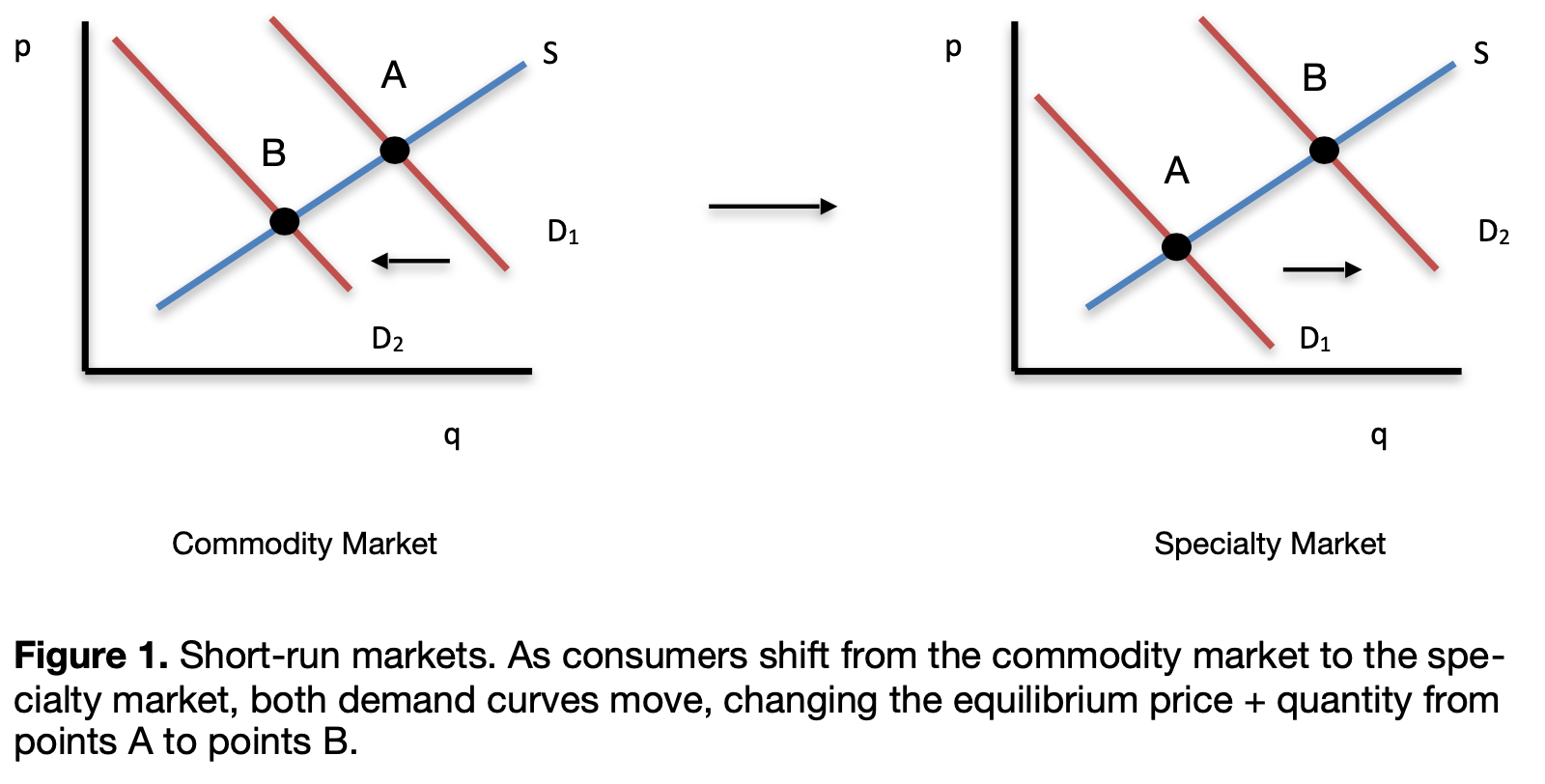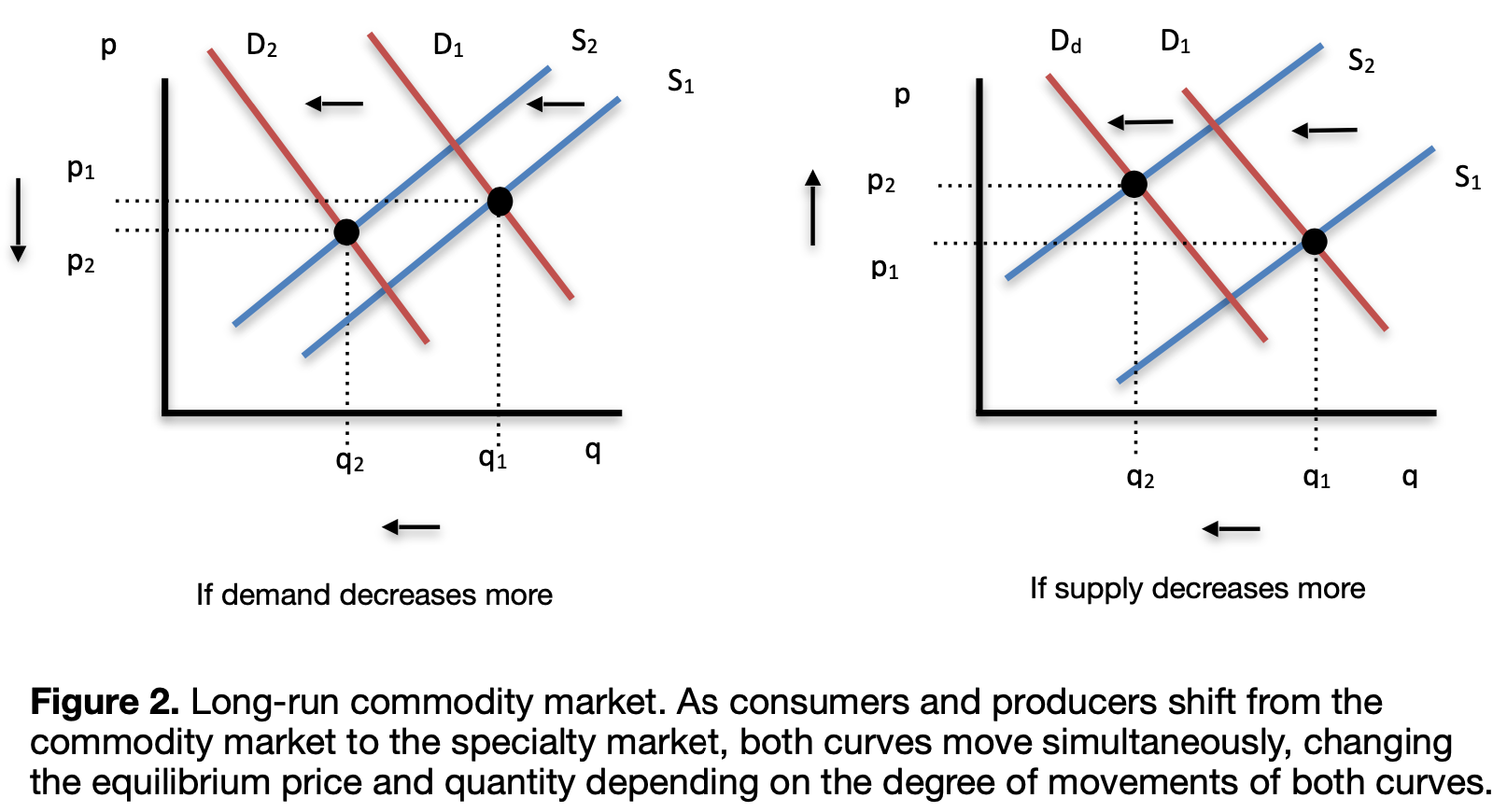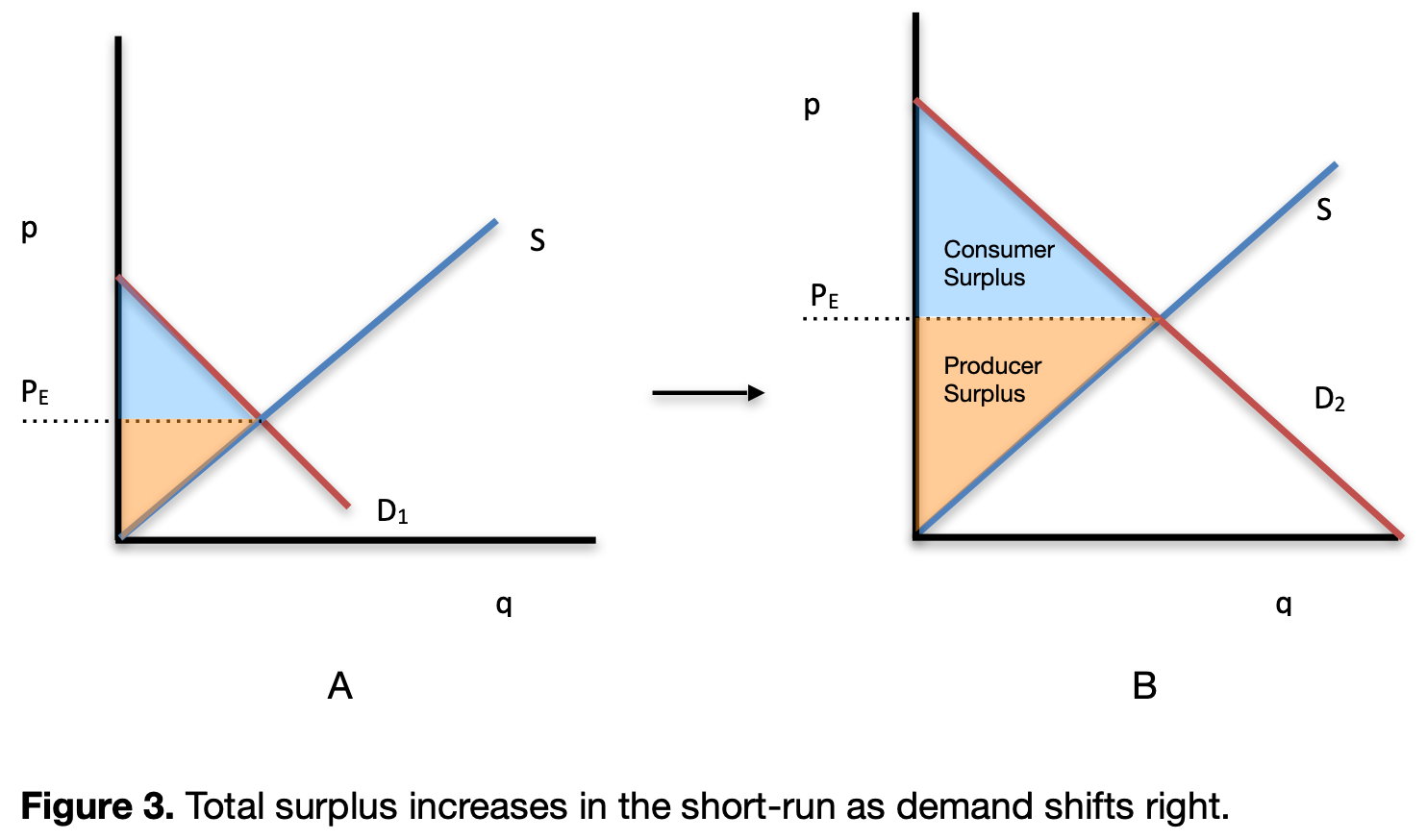This article was adapted from an assignment for an economics class I took in the Fall of 2019 as part of a horticulture degree program. The assignment was to find an article about an agricultural or food market and answer the question “Why did this market behave recently the way it did?”
The market I chose was the specialty coffee market and the behavior was local markets in Brazil and Colombia competing with export markets for locally produced, quality coffee. The original article I started with is Drinking Local – 25 Magazine, Issue 10 (archived link).
If I had to summarize my paper I would say this: increasing local consumption of coffee creates and expands markets giving everyone in that market a bigger piece of the pie, especially the producers who can use increased surpluses to improve their livelihoods, their production, etc.
Because my assignment paper was quite dry and at times too technical (in economics) for the blog, I’ve expanded on some of the specific terms and also made it a bit more approachable, but it’s still about economics. Reader be warned.
Historically, the best coffee produced by a country is exported for sale overseas in developed regions such as America, Europe, or Japan. However, in Brazil and Colombia, premium coffee is being sold locally at a higher price than for which it could be exported (Partida, 2019). Why then, is local coffee so expensive in Brazil and Colombia?
The commodity coffee market closely resembles a perfectly competitive market; nearly everyone is a price-taker. The market has well-defined product standards. It has many buyers and sellers. Productive resources are mobile, and buyers and sellers are well informed (Bhansali et al., 2012)
The specialty coffee market is a sub-market of the commodity market. Broadly speaking, the price for specialty coffee is based on the market price of commodity coffee with an added premium for quality, which is negotiated between buyer and seller (Donnet et al., 2008). Specialty coffee is defined as coffee with few defects and a quality score of at least 80 out of 100 points (Coffee Standards, n.d.).
See also: What Is Specialty Coffee
Specialty coffee has traditionally been exported from producing countries—typically poorer, developing countries—to developed countries.(Bhansali et al., 2012) This is because developed countries can afford the higher price of specialty coffee. This typically leaves only the lower-grade coffee to be consumed within the producing country, while potential profits from higher grade coffee are realized elsewhere.
Recently, two producing countries have reached a point where high-quality, specialty coffee is sold by local producers for local consumption at a higher price than could be obtained for export. Brazil and Colombia both have specialty coffee markets that have developed to the point where they are able to compete with export markets. What is driving this demand and what does it look like from an economist’s point of view?
The Brazilian Market
A growing middle class in Brazil means more disposable income, which means buying power, which means the ability to explore quality coffee. Enough people in Brazil are buying quality coffee that producers can get a higher price selling it locally than if they were to export it.
The Brazilian retail coffee market is a mature, well-established market that has been expanding in consumption around three to four percent (Rafael, 2019). Because of this expansion, the local market has reached a point in which it is able to compete with export markets. This trend is partly caused by an income effect—an expanding middle class.(Arnold & Jalles, 2014) This increase in income has two effects; first, individuals are able to afford to switch to the specialty coffee market and explore quality coffee and the lifestyle that goes with it, such as buying improved brewing equipment, taking coffee-appreciation classes, etc.
The second way it impacts the market is by shifting the specialty coffee market’s demand curve to the right, causing an increase in both the equilibrium quantity and the equilibrium price. In Figure 1, the demand curve in the specialty market shifts to the right from D1 to D2. The beginning equilibrium price and quantity pair starts at point A and shifts up and to the right along the supply curve to point B.

As consumers leave the commodity market, the short-run effects of the decrease in buyers is that the demand curve for that market shifts to the left, decreasing equilibrium price and equilibrium quantity as seen in Figure 1. As buyers continue to leave the commodity market and the equilibrium price continues to decrease, eventually producers will begin to exit the commodity market (hopefully to enter the specialty market). Once the market reaches a point where producers have had enough time to enter or exit a market, the long-run effects will include a leftward shift in the supply curve. Shifts in both supply and demand curves can have various effects on equilibrium price and equilibrium quantity, depending on the degree of shift (Figure 2).
When both supply and demand decrease (shift left), the quantity available decreases, as in Figure 2. In the case of export markets, this means less quality coffee is available for export and more of the quality coffee that a country produces remains in country. Quality coffee remaining in country can feed a virtuous cycle of pride in consuming delicious coffee produced locally, pride in having one’s produce enjoyed locally, and increased wealth remaining local. In other words, it perpetuates cultural identity and in this way it really is something worth developing.

The Colombian Market
A successful marketing campaign by the coffee industry in Colombia has helped increase the number of consumers of local, high-quality coffee, to the point where producers can get a higher price selling it locally than exporting it. While the cause of the increase in consumption is different from Brazil, the effects are exactly the same; a shift from commodity-export markets to local, specialty markets.
Increased coffee prices in Colombia have a different cause with a similar effect. In Colombia, the well-organized coffee industry started a marketing campaign called Toma Café, which encouraged consumption of locally produced coffee by exploring diverse coffee drink recipes and also by encouraging coffee consumption any time of the day, not just in the morning (Rafael, 2019). This campaign had the effect of increasing the population of potential buyers of locally produced, high-quality coffee. Like the income effect on the Brazilian market, this shifts the demand curve to the right. This increases the equilibrium quantity and the equilibrium price (Figure 1).
The Toma Café program increased the volume of coffee consumed by a reported 36% in seven years. This increase in consumption was stimulated by a campaign set to increase the promotion, education, research and innovation in local coffee. “It was about glorifying tradition and propelling modernity” (Sierra, 2019). Much like the tastemakers’ function, the Toma Café program taught consumers what good coffee is and more importantly, what good, locally produced coffee is and they included the producers in shaping the message.
To stimulate demand we created our own communication network to bring more reasons to consume and reduce the barriers.
(Sierra, 2019)
See also: In Defense of Tastemakers
New short-run markets take hold
There are two functions of price that are at play in both Brazil and Colombia. First is the rationing function, which distributes scarce goods to those consumers who value them most highly—those with the highest willingness-to-pay. In the case of specialty coffee in Brazil and Colombia, this means that local consumers who value premium coffee and are willing and able to pay higher prices get it before it goes to the export market. This both increases the size of the local market and decreases the size of the export market.
The second function of price is an allocative function, which directs resources away from overcrowded markets toward markets that are underserved. In Brazil and Colombia, the over-crowded market is the export market for commodity coffee and the underserved market is the local market for specialty coffee. Because of the allocative function, producers are incentivized to exit the commodity market and more are incentivized to enter the specialty market. The allocative function is what will hopefully keep coffee producers in the coffee industry, by encouraging them to participate more in the premium/specialty market and reduce their exposure to the more-volatile commodity prices.
Everyone gets a bigger piece of the pie
Consumer surplus is the difference between how much one is willing to pay and how much one actually pays for something—savings. Producer surplus is the difference between the price they are willing to sell for and the price they actually get. In both cases, the difference or surplus is money that can be spent elsewhere. When short-run demand increases significantly, total surplus does too, creating a more profitable environment.
Markets are developing in Brazil and Colombia to satisfy those buyers who value quality and are willing and able to pay for it. As demand for local, high-quality coffee increases, price increases and more producers are drawn into the market to exploit the opportunity presented by the higher prices. This expands the total market by drawing in more of both producers and consumers.
Total surplus is the sum of consumer surplus and producer surplus. In Figure 3, consumer surplus is represented by the light blue triangle and producer surplus is represented by the orange triangle. As the demand curve shifts right because of the income effect in Brazil and the increased potential population of buyers in Colombia, the total surplus in both markets expands. As total surplus expands, more producers have surplus with which to expand and improve their production and even to participate further in the local market. Consumer surplus means money saved that they were otherwise willing to spend on coffee, but can now spend elsewhere. Expanding total surplus gives everyone a bigger piece of the pie.

In both Brazil and Colombia, we are witnessing a short-run market in which the demand curve is shifting to the right and equilibrium price and quantity and total surplus are all increasing. Eventually, in the long-run, more producers will be incentivized by higher prices to join the local specialty market. Producers entering the market increase supply and shift the supply curve to the right. Eventually enough producers will enter the market that the increased supply will drive down the equilibrium price. But in the short-run there is profit to be exploited.
In conclusion, local, specialty coffee markets are developing in countries like Brazil and Colombia and these markets are making it more expensive to export specialty coffee than to sell it in the local market. This is a significant change in consumption patterns. The underlying causes for the increase in local consumption vary. In Brazil the cause is largely due to increasing purchasing power from increased incomes of the middle-class. In Colombia the cause is largely due to an increase in potential buyers from increased marketing efforts. For both countries however, the short-run effect is the same; an increase in equilibrium price and quantity and an increase in total surplus due to a shift in the demand curve. Eventually, more producers will enter the market to take advantage of the high prices and the long-run effects of increased supply will eventually be lower prices. This tug-of-war between supply and demand will lead to an expanding local market that will help to keep more products and profits in-country, thus increasing everyone’s wealth.
- Partida, V. (2019). Drinking Local. https://scanews.coffee/25-magazine/Issue-10/English/drinking-local-25-magazine-issue- 10/
- Bhansali, R., Bummara, J., Reddy, N., & Stern, K. (2012). The Trends of Coffee Futures.
- Donnet, M. L., Weatherspoon, D. D., & Hoehn, J. P. (2008). Price determinants in top-quality e-auctioned specialty coffees. Agricultural Economics, 38(3), 267–276.
- Coffee Standards. (n.d.). https://sca.coffee/research/coffee-standards
- Rafael, V. E. (2019). Markets in Producing Countries. In Re:co Podcast. https://sca.coffee/sca-news/podcast/72/reco-podcast-vera-espindola-rafael-on-markets-in-producing-countries-s4-ep-2
- Arnold, J., & Jalles, J. (2014). Dividing the Pie in Brazil: Income Distribution, Social Policies and the New Middle Class (Vol. 1105, Number 1105). https://doi.org/10.1787/5jzb6w1rt99p-en
- Sierra, A. M. (2019). The Colombian Toma Café Case. In Innovation and Integrative Marketing, the Engine For a Sustainable Market Growth. http://www.ico.org/documents/cy2018-19/Presentations/promotion-item-4-toma-cafe-case.pdf
